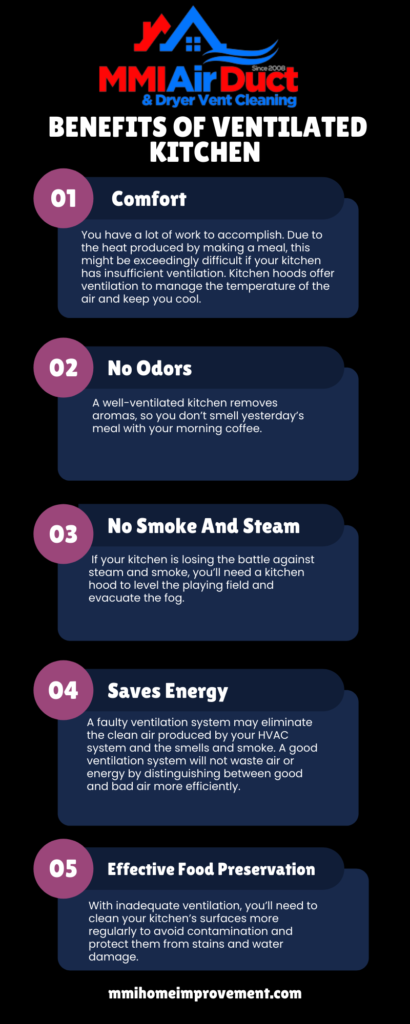When homeowners consider air ventilation in the kitchen, particularly those who have never constructed or remodeled a kitchen before, they consider the removal of smoke, steam, grease, and aromas. True, a well-ventilated kitchen reduces them, but ventilation performs an even more significant role: it improves indoor air quality (IAQ).
Why Proper Kitchen Ventilation is essential
Steam, smoke, gas fumes, and other contaminants may wreak havoc. Especially, on the air quality in your house if you’re not cautious. They cause pollution, exactly like the air pollution we see outside. According to GreenGuard, indoor air is often two times more polluted than outside air. Moreover, we spend the bulk of our time indoors, where we are exposed to environmental toxins. To improve the ventilation, learn more about the purpose of HVAC diffusers and grilles.
Your kitchen ventilation system does more than just clear the steam from the pasta pot or protect your walls from accumulated grease. Here are some crucial considerations to take when creating a kitchen ventilation system. Your system should be functional and complement your kitchen decor.
Oven Hood Air Ventilation In The Kitchen
Updraft and downdraft ventilation systems are the two types of ventilation systems. Both are examples of exhaust systems. The unwanted smells and particles are evacuated from the house via a duct system.
Updraft Systems:
These systems draw vapor, moisture, and smoke up and out of your home via a roof or exterior-wall mounted vent. They’re installed above the cooking area. Previously, hoods were bulky and heavy. However, contemporary design has compelled ventilation designers to be more inventive. Lower-profile variants draw impurities to the hood’s corners rather than the center. Thus, allowing them to exist as flat or slightly curved, low-profile panels. Because they are the most effective, updraft systems remain the preferred alternative.
Downdraft Systems:
Downdraft systems are built into kitchen equipment. They suck contaminants across the cooktop. Thus, trapping them before they can rise into the living space, and then pull them down through a duct leading out of the house. These vents are aesthetically distracting, but they are also popular when homeowners place cooking equipment on a kitchen island. Keep in mind that downdraft ventilation is less efficient than updraft ventilation.
Furthermore, because the blower action occurs closer to the surface, gas cooktop flames may be impacted slightly, as if they are being dragged in a little sideways direction.
System Of Recirculation:
These systems are less IAQ-friendly. However, they are frequently required in multi-family dwellings or when an exhaust system is not practicable. These circulate air through a filter before returning it to the living room. These include recirculating hoods and microwave hoods. If IAQ is essential to you, clean the vent and replace the filter according to the manufacturer’s instructions. In other cases, recirculating systems will become utterly useless over time.
The function, power, and size of these units vary. Some are intended to filter dust and allergens, while others filter mold, humidity, and pet odors. The air purifier with permanent or washable pre-filters, on the other hand, is ideally suited for a kitchen. These items are relatively simple to keep and clean. If you choose an air cleaner with HEPA filtration, you will also get rid of 99.97 percent of 0.3-micrometer dirt.
Natural Ventilation Is Beneficial As Well
Don’t overlook the advantages of natural air through a cracked or open kitchen window. It is a good way to get some fresh air into the house. We often overlook this issue in an era where central air conditioning is the standard-setting. Additionally, the same window will also let in plenty of natural light.
Working with a professional kitchen design and construction team is an excellent method to guarantee that your kitchen’s ventilation system is functional and aesthetically beautiful. To understand more about the intricacies of healthy kitchen ventilation, please contact us for air duct sanitizing in Marietta.
Kitchen hoods may not be the most interesting aspect of kitchen design, but they are crucial to any redesign. These kitchen accessories make the kitchen more comfortable and keep new additions looking new for longer.
Top Five Benefits Of Ventilated Kitchen:
We’ll discuss why proper ventilation in the kitchen is so vital and how to achieve it with the correct kitchen hood. If you don’t have a range hood and want one to install then call us to get a range hood duct installation service in Marietta or any nearby city of Georgia state. There are several reasons why every homeowner requires enough ventilation in their kitchen. Here are the top five.
1. Comfort:
When you’re cooking, the last thing you want is to be hot. You have a lot of work to accomplish. Due to the heat produced by making a meal, this might be exceedingly difficult if your kitchen has insufficient ventilation. Kitchen hoods offer ventilation to manage the temperature of the air and keep you cool.
2. No Odors:
It’s enticing to walk through the front door and smell a delectable food sautéing on the burner. Smelling that dish days afterward is repulsive. A well-ventilated kitchen removes aromas, so you don’t smell yesterday’s meal with your morning coffee.
3. No Smoke And Steam:
Does your fire alarm sound every time you try to blacken a piece of fish or brown some chicken? This false warning might be due to insufficient airflow rather than a picky smoke detector. If your kitchen is losing the battle against steam and smoke, you’ll need a kitchen hood to level the playing field and evacuate the fog.
4. Saves Energy:
Cooking hoods enhance kitchen conditions, but they may also help you save energy in your house. A faulty ventilation system may eliminate the clean air produced by your HVAC system and the smells and smoke. A good ventilation system will not waste air or energy by distinguishing between good and bad air more efficiently.
5. Effective Food Preservation:
When you cook with little ventilation, the air quality suffers. food particles and odor circulate throughout the kitchen. It can not only pollute but also harm surfaces. With inadequate ventilation, you’ll need to clean your kitchen’s surfaces more regularly to avoid contamination and protect them from stains and water damage.

Use the below code to Embed this infographic
Different Shapes and Sizes of Kitchen Hoods
The appearance of a kitchen hood can assist you in determining where it should be positioned. We normally install A narrow, virtually flat hood behind our kitchen cupboards. On the other hand, wall-mount kitchen hoods resemble an upside-down letter Y, while island-mount range hoods resemble an upside-down letter T. The various forms and designs are more about installation choice than stylistic preference.
Conclusion:
In conclusion, we can say that air ventilation in the kitchen is very important. It not only regulates the optimum temperature but also the air quality.
Must Read: How To Repair Holes In HVAC Ducts – Complete Guide
